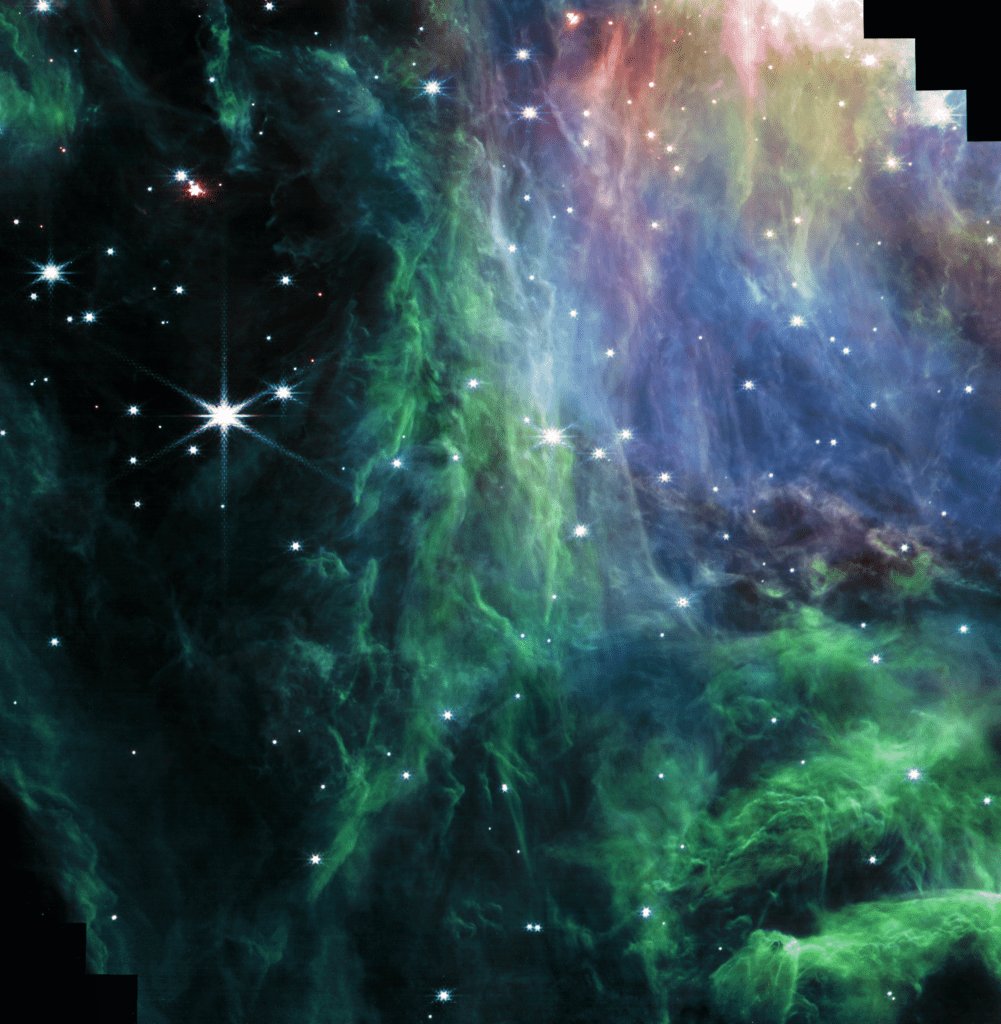Most of the objects the JWST has studied are so faint they can’t be seen with binoculars, let alone the naked eye. The Orion Nebula, sometimes known as the Great Nebula or M42, is different. It’s the closest star-forming region to Earth and looks like a fuzzy star in Orion’s sword in the constellation. Even a modest amateur telescope reveals the nebula’s shape and some of the newborn stars, so imagine what the most powerful space telescope ever launched can see. Well, now you don’t have to because the images have arrived.
Until quite recently, astronomically speaking, the Orion Nebula was a cloud of gas containing thousands of times the mass of the Sun. Back then we could only have really seen it because it blocked out any stars behind. Then the gas started condensing into new stars, some of them very large. Although the stars have yet to reach their peak brightness they are already throwing out enough light to illuminate much of the remaining gas. It is thought the Sun and Earth formed in a nebula much like this one 4.5 billion years ago.
The nebula is around 24 light-years across and 1,344 light-years away, but the JWST can image it with a resolution of about 5 light hours, or about the distance from the Sun to Neptune. That allows us to see detail in protoplanetary disks around some of the 700 or so stars that have begun to shine within the nebula.
The northern region of the M42 (Orion Nebula) in maximum detail. Some of the team working on this observation claim to see a frog in there. Image Credit: NASA, ESA, CSA, PDRs4All ERS Team; image processing Salomé Fuenmayor
“These new observations allow us to better understand how massive stars transform the gas and dust cloud in which they are born,” said Professor Els Peeters of the University of Western Ontario in a statement.
“Massive young stars emit large quantities of ultraviolet radiation directly into the native cloud that still surrounds them, and this changes the physical shape of the cloud as well as its chemical makeup. How precisely this works, and how it affects further star and planet formation is not yet well known.”
Three stars in the nebula and some of the gas filaments seen in even greater detail in breakout boxes. Image Credit: NASA, ESA, CSA, PDRs4All ERS Team; image processing Salomé Fuenmayor
“We clearly see several dense filaments. These filamentary structures may promote a new generation of stars in the deeper regions of the cloud of dust and gas,” Dr Olivier Berné of the Institut D’Astrophysique Spatiale added.
“Inside its cocoon, young stars with a disk of dust and gas in which planets form are observed in the nebula. Small cavities dug by new stars being blown by the intense radiation and stellar winds of newborn stars are also clearly visible.”
The Spitzer space telescope operated at wavelengths similar, but with rather lower resolution. Image Credits: NASA, ESA, CSA, PDRs4All ERS Team; image processing Olivier Berné/ NASA/JPL-Caltech/T. Megeath (University of Toledo, Ohio)
The JWST’s images are always more spectacular than those taken by Hubble simply because the new telescope has a much larger primary mirror to collect more light. However, the difference is particularly marked here, because Hubble’s view, like that of most Earthly telescopes, is shrouded by dust that largely blocks out visible light. Infrared light, which JWST sees, is much less affected by dust – the infrared capacity was chosen in part for its ability to see into regions like this one.
Comparison between how the two space telescopes see the same inner area of the nebula, showing off the JWST’s greater power to peer through dust. Image Credit: NASA, ESA, CSA, PDRs4All ERS Team; image processing Olivier Berné
Source Link: JWST To Reveal Secrets Of Star Birth With Gorgeous New Orion Nebula Image
